Alien Nummo Appear on Peruvian Artifacts
Updated June 2023
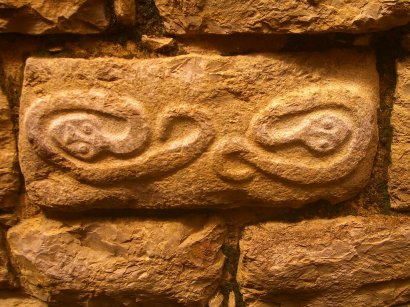 Twin Serpents at Kuélap by Von luiluilui - Eigenes WerkVon luiluilui - Eigenes Werk, CC BY-SA 3.0, https://commons.wikimedia. org/w/index.php?curid =10753821 |
This twin serpent relief showing serpents in opposite directions is found on the inner wall of the Peruvian Kuélap fortress. It was built by the Chachapoyas people, who were known as the "Warriors of the Clouds".https://en.wikipedia.org/ wiki/Chachapoya_culture Dated to the 6th century, it has finely worked limestone blocks of masonry with some weighing as much as three tons.https://en.wikipedia.org /wiki/Ku%C3%A9lap
According to the African Dogon elder Ogotemmêli, even though the alien Nummo were a type of fish-tailed catfish, they looked like "serpents" when they moved on land. They were depicted as twins in opposite directions on Dogon carvings, which I believe associates them with this carving from Kuélap.Dorey, Day of the Fish pp. 137-154
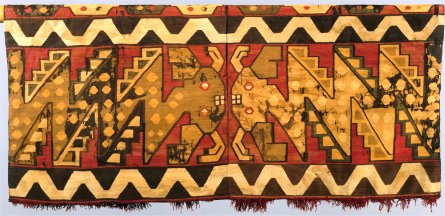 Nazca-Wari Tunic 800-850Gift of George D. Pratt, 1929 https://www.metmuseum.org/ art/collection/search/307975 |
This Camelid hair, tapestry-weave tunic, which shows dual catfish with serpent-like bodies, comes from the Nazca-Wari culture of Peru. Dated from 800 to 850, this Peruvian tunic clearly reveals the significance of the dual serpent-like catfish to Peruvian cultures. "Its main pattern consists of two catfish with spotted zigzag bodies facing each other at the center line of the tunic."Gift of George D. Pratt, 1929 https://www.metmuseum.org /art/collection/search/307975
The zigzag line is an important symbol in the Dogon religion as the catfish Nummo had these zigzags or chevrons along their backs.Dorey, The Master (Mistress) of Speech p. 85 The catfish on the tunic also have red eyes like the Nummo. Two red beads worn on the nostrils of some of the Dogon people celebrated the Nummo and depicted their red eyes.Dorey, The Master (Mistress) of Speech p. 15
The wearing of special tunics like this one had religious, ethnic and social significance in the Nazca-Wari culture.Tunic with Confronting Catfish, Nasca-Wari Culture, Met Museum https://www.metmuseum.org /art/collection/search/307975
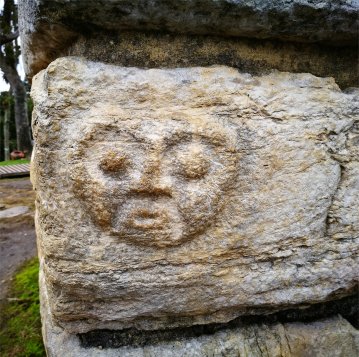 Kuélap Bas-reliefBy Pitxiquin - Own work, CC BY-SA 4.0, https://commons.wikimedia.org/w/ index.php?curid=59737733 image cropped and reduced |
This bas-relief depicting a deity on the wall of the Kuélap fortress is reminiscent of the fish-tailed Master (Mistress) of Speech (the Seventh Nummo Ancestor), who had wide-open eyes and was depicted with a round open mouth on Dogon carvings.Dorey, Day of the Fish p.100
Her round mouth symbolized a full moon. The Dogon believed the moon increased in size when the Master (Mistress) of Speech breathed and opened her mouth to "speak."Dorey, Day of the Fish p.100 When the moon was full, her speech was believed to benefit humans the most because the moon reflected sunlight, mimicking the fact that the Dogon believed we once had two suns in the solar system.Dorey, The Rose p. 271
The Dogon associated the duality of the sun with immortality. This was in contrast to a new moon, which was first visible in the sky after we lost our second sun. A new moon was called olo "dark" and was a symbol of our lost immortality.Dorey, The Rose p. 271
The Dogon also said that on the day the alien Nummo Ancestors returned to Earth, their descent was accompanied by a full moon.Dorey, Day of the Fish p.100
The Kuélap fortress is located in the northern Andes at around 2900 meters (9,512 feet) above sea level over the river valley of the Río Utcubamba.https://en.wikipedia.org/ wiki/Ku%C3%A9lap? The Nummo liked to live high in the mountains, in water, or deep in underground tunnels and caves.Dorey, The Master (Mistress) of Speech p. 24 Because of its height and location near the river, the Nummo may have been associated with the Kuélap fortress.
 Kuélap Fortress by JYB DevotKuélap Fortress, Luya, Amazonas, Peru By JYB Devot - Own work, CC BY-SA 4.0, https://commons.wikimedia. org/w/index.php? curid=74023299 |
The architecture of the Chachapoyas is characterized by circular stone constructions as well as raised platforms constructed on slopes. The region was relatively isolated from the coast and other areas of Peru.https://en.wikipedia.org/wiki/ Chachapoya_culture
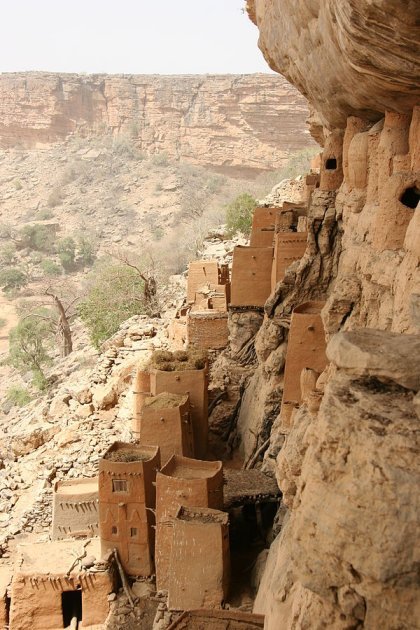 Bandiagara Cliff DwellingsBy Ferdinand Reus from Arnhem, the Netherlands - Cliff Dwellings in the Bandiagara escarpment in the Sahel region of Mali., CC BY-SA 2.0, https://commons.wikimedia. org/w/index.php? curid=2715458 |
The sandstone Cliff of Bandiagara, where some Dogon people still live, is located about 500 meters (1640 feet) above the hill flats in Mali, Africa.https://en.wikipedia.org/ wiki/Bandiagara_Escarpment The location was so isolated and difficult to access, that the Dogon people were one of the last groups in Africa to come under French rule. Like the Chachapoyas, the Dogon dwellings were embedded into the slopes.Dorey, The Master (Mistress) of Speech p. 11
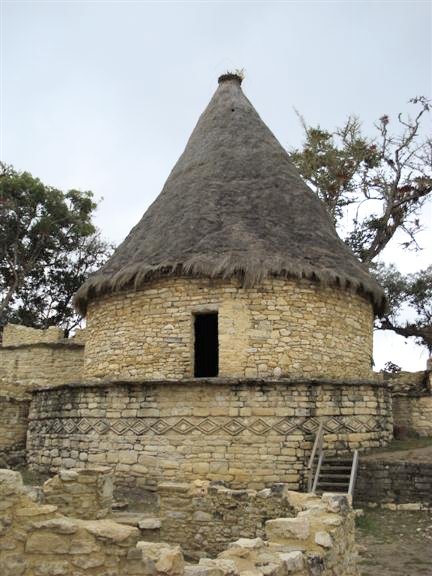 Kuélap Restoration by Harley CalvertKuélap Restoration by Harley Calvert - Own work, CC BY-SA 3.0, https://commons.wikimedia.org /w/index.php?curid=26547089 |
This photo by Harley Calvert shows the circular construction found at Kuélap. Compare it with the Dogon toguna, which mimicked the building where the Eight Nummo Ancestors held counsel when they lived on Earth.Dorey, The Master (Mistress) of Speech pp. 178-179
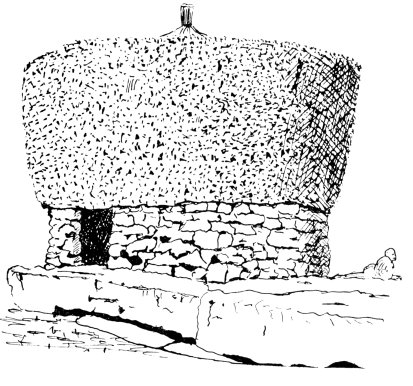 toguna D'Ouroli TennéReplication from Masques Dogons by Marcel Griaule, (1938), p. 19 Z. Toguna D'Ouroli Tenné |
Special buildings in the Dogon village, like the toguna were made circular.Dorey, The Master (Mistress) of Speech pp. 178-179 This sketch, circa 1930s, depicts the toguna at D'Ouroli Tenné.Replication from Masques Dogons by Marcel Griaule, (1938), p. 19 Z. Toguna D'Ouroli Tenné
According to the Dogon elder Ogotemmêli, toguna were either circular, with a millstone shaped like a section of an inverted cone on top, or orientated according to the cardinal points.
They have, or should have, three rows of pillars lying north to south, the two side-rows having three supports and the middle-row two supports, arranged in the form of a quincunx. These stumpy pillars, made of firmly balanced stones, sometimes covered with a coating of whitish grey mud, stand like the trunks of the Eight Ancestors when seated in council with their heads in the rafters of the roof.Dorey, The Master (Mistress) of Speech pp. 178-179
One of the structures at Kuelap, known as Templo Mayor (Main Temple) has the shape of an inverted cone and was believed to have been used as a solar observatory.https://en.wikipedia.org/ wiki/Ku%C3%A9lap
The Chachapoyas were conquered by the Inca Empire prior to the Spanish conquest in the 16th century. "Despite the archaeological evidence that people began settling as early as 200 AD or before, the Chachapoyas culture is thought to have developed around 750-800 AD.""https://en.wikipedia.org/ wiki/Chachapoya_culture
The Kuelap Fortress has more than four hundred interior buildings and massive exterior stone walls reaching upwards of 18 meters (60 feet) in height.https://en.wikipedia.org/ wiki/Chachapoya_culture There are water canals made of stone, which are believed to have supplied water to the settlement from a spring at the top of the mountain.https://en.wikipedia.org/ wiki/Ku%C3%A9lap
This is important because the Nummo needed to keep moist in order to stay alive. Moisture was seen as the life-force. Ogotemmêli said that allowing the Serpent to sweat would rob him [her] of his [her] strength and he [she] would die.Dorey, The Master (Mistress) of Speech p. 22
For more information on the Dogon religion refer to my books, The Master (Mistress) of Speech, The Nummo, Day of the Fish and The Rose.